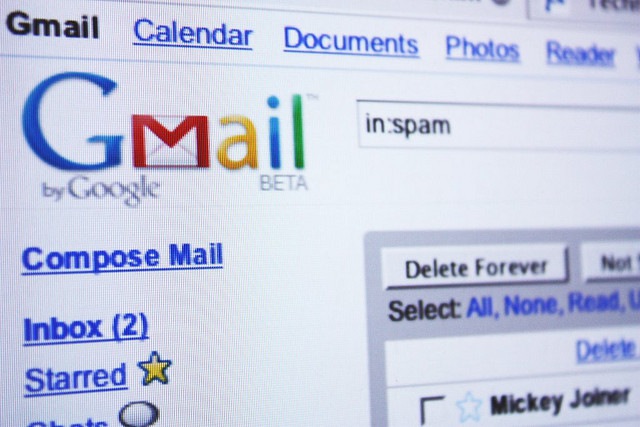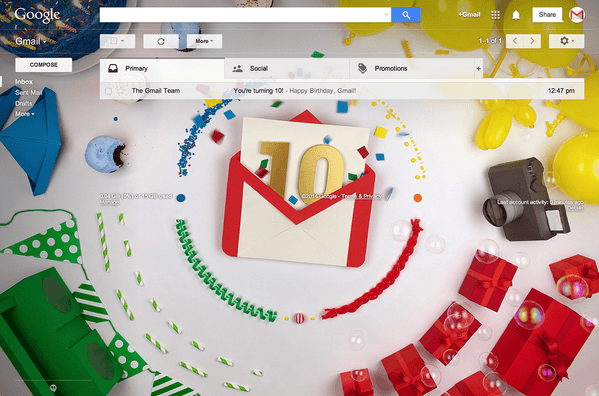Gmail just turned 10. We know. Where does the time go? It only seems like just yesterday we were hoping someone we knew would give us an invitation. While some of us may have given that coveted invite to join Gmail, many had to pine for years. Gmail was loaded with features that Yahoo, AOL, or Hotmail simply couldn’t compete with, like an insane amount of free storage. In other words, we weren’t one of the cool kids without a Gmail account. But, all good things happen for those who wait. And, hopefully you now possess an awesome Gmail account (if not, you probably should).
To celebrate its 10th anniversary, here are 10 things that you should probably know about the world’s most popular email provider.
1. Paul Buchheit: The Man Behind Gmail
Paul Buchheit was the man behind Gmail, as well as the developer for the prototype for AdSense and Google’s company motto “Don’t be evil.” The idea for a web-based email came to Buccheit while working on a personal email software project as a college student in the 1990s, which was prior to the launch of Hotmail.
After becoming the 23rd employee at Google, Buchheit worked on Google Groups, but was eventually asked “to build some type of email or personalization product.” He created the first version of Gmail in just one day by reusing code from Google Groups. The software was initially only available for Google employees to use, but Buchheit noticed that the high volume of internal email had created “a very big need for search.”

2. Invites Only
Google concluded its five-year beta phase in March 2004 after it had invited 1,000 opinion leaders, along with their friends and family, to become testers. Despite going public on April 1, 2004, people still needed invites during this beta phase. Invites were so in-demand that people spent over $150 on eBay for the coveted invite. Sites, such as Google Swap, also appeared and would donate invitations to people who needed one.
The beta phase officially ended in July 2009.
3. How Many Google Employees Does It Take to Launch Gmail?
It may sound unbelievable now, but there were only around a dozen Google employees working on Gmail when it launched.
4. What on Earth is a Googlette?
According to the following Craigslist job posting in 2003, Google called Gmail, as well as other other projects, Googlettes.
What is a Googlette? It’s a new business inside of Google that is just getting started – the start-up within the start-up. We’re looking for an experienced, entrepreneurial manager capable of offering direction to a team of PMs working on a wide array of Googlettes. You will define Google’s innovation engine and grow the leaders of our next generation of businesses.
5. Project Caribou
Caribou was the code-name for Gmail. Caribou was chosen in honor of the Dilbert comic strip’s ‘Project Caribou.’
6. Google Loves April Fool’s
Launching Gmail on April 1, 2004 was intentional. Since then, the company, which had been known for April Fool’s hoaxes, has had some fun with the following hijinks:
- 2007 – Google introduced “Gmail Paper.” This was where a user would click on a button and Gmail would supposedly mail an ad-supported paper copy email archive for free.
- 2008 – “Gmail Custom Time” was introduced and allowed users to send out up to 10 emails per year with forged timestamps. The hoax even claimed that the emails were routed through the fourth dimension of time itself before reaching their intended recipient thanks to bending the spacetime on the Google servers.
- 2009 – Google introduced a new service dubbed Gmail Autopilot by CADIE. This would automatically read and respond to emails for the user. It accomplished this by analyzing messages for the emotions that were included in the body and would then offer advice to the user or automatically respond to the email.
- 2010 – Google suffered a vowel outage for the English-language home page for Gmail, which also included its logo.
- 2011 – “Gmail Motion” was unveiled and gave users the opportunity to navigate through emails, send and even dictate messages through their physical actions by utilizing webcams. For example, if a person wanted to send an email, they would perform the action of licking a stamp, and posting it. Once a user signed up for the new service, they would be directed to an “April Fools'” message.
- 2012 – Google introduced “Gmail Tap,” which was an application for Android and iOS that could be used to double typing speed via a revolutionary new keyboard. The system included a keyboard containing three keys: Morse code “dash” and “dot”, and a spacebar (along with backspace). Just before midnight on March 31, users attempting to download the app received the following message: “Oops! Gmail Tap is a bit too popular right now. We suggest you try downloading it again on April 2nd.”
- 2013 – “Gmail Blue,” was another service introduced for April Fool’s This was an application that not only allowed Gmail to have additional features, but to become completely blue in color.
- 2014 – The “Shelfie” was service introduced for the 10th Anniversary of Gmail. This gave users the chance to share selfies with all of their contacts in the background of the email window.
7. Is There a Storage Problem Here?
When Google announced that it’s email service would come equipped with 1GB of storage many thought that it was just an April Fool’s prank. Why would people need so much storage? And, was it even possible to offer that much storage capacity? After all, competitors were offering maybe 10 MB.
However, when Gmail celebrated its first anniversary Georges Harik, product management director for Gmail, made the claim that Google would “keep giving people more space forever.” And, that statement became true.
For example, on April 24, 2012, Google announced the increase of free storage in Gmail increased its free storage from 7.5 GB to 10 GB during the launch of Google Drive. On May 13, 2013 Google announced that it was merging storage from Gmail, Google Drive, and Google+ Photos. This gave users an incredible 15 GB of free storage, which is the standard amount of storage today.
If users need more storage, they can purchase additional storage through a monthly subscription plan which can go as high as 30 TB.
8. Gmail: An AJAX Pioneer
According to Time: “With Gmail, Buchheit worked around HTML’s limitations by using highly interactive JavaScript code. That made it feel more like software than a sequence of web pages. Before long, the approach would get the moniker AJAX, which stood for Asynchronous JavaScript and XML; today, it’s how all web apps are built. But when Gmail was pioneering the technique, it wasn’t clear that it was going to work.”
In fact, when Gmail introduced Chat in February 2006, it was able to integrate the new service because of AJAX coding.
9. Gmail Visitors By Country
According to Alexa, 24.4 percent of users in India have a Gmail account. The United States is second with 11 percent, followed by Brazil (8.5 percent), Indonesia (4.8 percent) and Italy (4.2 percent).
10. How Popular is Gmail Today?
By 2012, Gmail officially became the world’s largest email provider after surpassing Hotmail. Today, Gmail can be found in 57 languages, and is used by approximately 500 million people worldwide.
Do you have a Gmail account? If so, what features do you think make it so popular and effective?
Image Credits
Featured Image: Gmail Official Twitter Account
Image #1: notoriousxl via Flickr




